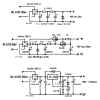|
background
I designed this
DI-box in the middle of 1970 when I worked as a recording engineer.
During this period, there were mostly just home-built passive DI-boxes with
small transformers like Beyer, KeMo or Sennheiser, around the studios here in
Sweden.
When I recorded electric bass guitar, I always missed the clear steady bottom,
so I have to do something about it, and the result was the "DI-box
1975", whish I now present here as a DIY project.
For information, advice and praise from
many who have built this DI-box around the world
can be read here on Group
DIY forum over 300.000 visitors have been there.
circuit discription
This design is not "rocket
science" it is a simple basic circuit that is easy to build and easy to get
to work, but it is still of top quality that is hard to beat.
The front-end transistor is not of a JFET/field effect type that is normally in
a DI-box, this design uses instead a bipolar silicon transistor.
The advantages are that they are easier to find on the market, and they are also
more reliable.
The disadvantage is the difficulty in obtaining high input impedance as 10 Mohm,
but 1 Mohm is ok, and good enough for this application.
An interesting note is that around 1 Mohm is probably one of the most common
impedances on guitar and bass amps of all time, and is probably the reference
impedance that the pickup manufactures use.
The circuit is a buffer amp
consists of two emitter followers, the first one with low current to ensure high
input impedance and low noise, and the second with higher current to deliver
good drive capacity for the output transformer.
The internal voltage supply is selected to 24 volt to get a compromise between
good headroom and low current consumption.
There is no groundlift switch that is normal, but instead uses a ground loop
supressor built around two diodes, a resistor and capacitor, resulting in a safer
operation for the DI-box electronics.
There is also a protection circuit for the input, consisting of two zener diodes
and a resistor.
This offers a good protection against high signals such accidentally connected
speaker signal.
some important construction hints
metal box/case ground
The metal case/housing for the DI-box electronics, shall only be
grounded on the XLR output
connector pin 1, and
also connected to a solder tag fixed in one of the XLR fasten screws.
(this is the only ground connection to the
metal case)
Then a additional cable from XLR pin 1 to the electronic ground
system rail (the
bottom line in the schematic) in series with the 0,1 uF, 100 ohm and the
two diodes.
isolated plastic jacks
The two tele jacks must be isolated from the metal box, use plastic jacks, with plastic nut or crome nut with isolated washer,
the jacks ground/sleve shall only be connected in the
electronic ground system rail.
This is very important, to get the ground loop suppressor to function properly.
shortet input
jack
The input jack should be shorted to ground when it is un-plugged.
There is an extra connection/solder tag for the rear tip contacts that is the
brake switch, this connection/solder tag shall be connected to the ground on the
input jack.
(the link can be seen in the picture of the input jack mounted in the lid)
This removes noise, hum and interference with un-plugged input jack.
transformer
case ground
The metal casing of the transformer shall only be connected to the electronic
ground system, and not in contact with metal box.
it is not unususal that there is an extra cable or connector pin for the
transformer core, this must also be connected to the electronic ground system.
LED type and
connection
(pc-card version)
Use a 3 or 5 m.m. red LED, because the low voltage drop. (other colours have higher
voltage drop)
If the LED is mounted visible from the outside from the box, it must of course
be connected with loose cables from pcb.
The long leg shall be connected next to the two 6,8K resistors.
If the LED is not used, use a link instead of LED.
some small electronic corrections
not corrected in the schematic
improved the bias
stability
change the two 470 kohm to 100 kohm
change the 1 uF to 10 uF/35 volt
to reduce the
component supply
change 47 ohm to 100 ohm
change 0,047 uF to 0,1 uF
transistor
choice
This design accepts almost all transistors that are of a general purpose
small signal amplifier type.
It is of course preferable to choose a low-noise type with the best selections
of hfe, to ensure
that the transistor is doing a good job in this DI-box circuit.
Use only good
brands and types such as Philips, SGS/Ates, Motorola, National, Fairchild.
For pc-card
version, it is good if the transistors have same pin-out/package outlines as orginal
NPN BC550C and PNP BC560C, and having legs arranged from left to right C-B-E. (seen
from the top with the text facing you)
This package outline is called TO92 / TO226AA, case 29-04, style 17, according
Motorola standard.
Here are some recommending European types that fits well:
BC550C = BC550B, BC549B/C, BC548B/C, BC547B/C, BC414B/C,
BC337-25/40, BC237B/C, BC184B/C
BC560C = BC560B, BC559B/C, BC558B/C, BC557B/C, BC416B/C, BC327-25/40, BC307B/C,
BC214B/C
There are also
many other useful transistor types in the U.S. package outline style, with legs
arranged from left to right E-B-C, and this package outline is called TO92 /
TO226AA, case 29-04, style 1.
This version will fit on the pc-card if the transistor is rotated a half turn.
Here are some
recommending U.S. types:
BC550C = 2N3391A, 2N3904, 2N4401, 2N5088, 2N5210, MPSA18
BC560C = 2N3906, 2N4403, 2N5087,
To make it even
more complicated, so there is an additional U.S. package outline wish is also
used in Japanese transistor types.
This version have the legs arranged from left to right E-C-B, and this package
outline is called TO92 / TO226AA, case 29-04, style 14.
If this version
will fit on the pc-card you have to cross the C and B leg.
Put on a piese of insulation sleeving on one crossed leg, in order to avoid
short circuit between them.
Here is some
recommending types:
BC550C = 2N3707, 2SC1775-AE, 2SC1815-GR/BL, 2SC2240-GR/BL
BC560C = 2N3703, 2N4058, 2SA872-AE, 2SA1015-GR/BL, 2SA970-GR/BL
other componet choices
The resistors can
be standard 5% 0,25w carbon film, except for the two 6,8k that need to be 1%
0,25w metal film. (or use 1% 0,25w metal film for all resistors)
All capacitors of radial lead types, capacitance tolerance 5 to 20 %
0,1 uF capacitors of polyester or polypropylene type, minimum rated 50 volt,
pitch between legs 5 mm.
10 uF and 100 uF aluminium
electrolytic
capacitors minimum rated 35 volt, pitch between legs 2-3,5 mm.
Zener diods 12
volt 500mw/0,5 watt. (for example BZX55-C12, BZX79-C12, 1N759, 1N5242)
Diodes 1N4004, 1 amp 400 volt. (1N4004 to 1N4007 is ok to use)
Good choice of
plastic jacks are:
(you can use the
same type but with PCB
pins if normal
solder lugs is
sold out)
Cliff CL1160A / S2BNB, (CL1169 / S2BNBPC)
Neutrik NMJ4HFS, (NMJ4HFD2)
Rean NYS2122, (NYS2162)
transformers
three types that fit directly
into the PCB layout
Lundahl LL1538 configuration for 1:5 ratio
or LL1538XL for more low end headroom
data
sheet
transformer connection:
pin 6 to amp output (10 uF and 10 kohm)
pin 5 to ground rail
pin 1 and 4 to XLR pin 2
pin 2 and 3 to XLR pin 3
pin 8 to ground rail.
buy Lundahl
transformers
here
Haufe ST8456
a good alternative to Lundahl.
ordering
can be done here
OEP A262A3E
price cheaper than above, but still
good quality.
data sheet
data sheet
buy OEP transformers
here
here
Transformer
comparison
I
have done some measurements on the Lundahl LL1538, Haufe ST8456 and Walters OEP
A262A3E, in my DI-box circuit.
Here
is a brief comparison of the three transformers that fits the circuit board
layout.
Lundahl
and Haufe have near same behavior from 100 Hz and up, but Haufe are a bit better
in low end small signal distortion, and Lundahl have lower distortion in low end
near saturation point.
Both have
a very good square wave response, and have 14 dB loss with 1 kohm total load.
OEP
have approx. 10 times higher distortion from 100 Hz and down, and have also
higher distortion in the high end, but have ok square wave response, slightly
rounded, with out ringing or overshoot.
Because
the 6,45:1 ratio, it have 16 dB loss.
All
three sounds nice in my DI-box, but Lundahl LL1538 are still the best with a
steady and clean low bottom and a fast and clear high end.
Lundahl
LL1538XL have very near same specification as LL1538, but because it have
approx. 45% bigger core, it can handle 3 dB more level.
Other transformers
There are lots of
other good mic transformers with ratios around 1:5 which can be used backwards
in 5:1 configuration for this DI-box design.
These do not fit directly on the pc-card so they may be connected with loose
cables.
The transformer housing must be isolated from the DI metal box if it is mounted
outside the pc-card, but it must be connected to the pc-card electronic ground
system.
here are some good
brands and types that can have a nice character and personality.
Amplimo TM2P
Cinemag CMMI-5C, CMO-5/200CT
Jensen JT-13K6
Lundahl LL1528, LL1578
Sowter 3678, 8230, 9045, 9145
Steven & Billington 829
The old famous
Neve/MarinAir/St.Ives 10468/VT22670/T1454 mic input transformer, configurated in
ratio 4,8k to 300 ohm can also fit very nice.
It is manufactured today by:
Carnhill VTB-9045
Sowter 9145
boxes/enclosures and metal work
Metal boxes of die cast
aluminium is very practical and easy to use.
An example is my prototype pictured here, where I have assembled everything in
the lid.
This box is manufactured by Deltron, type number 461-0040, LxWxH 114x65x55 mm,
painted in light gray.
The disadvantage of this box is the small inside depth, only Lundahl LL1538 and
Haufe ST8456 will fit,
LL1538XL and OEP A262A3E are too high.
If you are not so
mechanically handy, it is better with a larger box where the pc-card is mounted
on the bottom and contacts around the sides.
A suitable box for this is Hammond type number 1590-TBK, LxWxH 121x80x55 mm,
painted in satin black.
Install the
pc-card with 4 pcs. 6 mm spacers with 3 mm hole (or three nuts), to get a distance between the pc-card
and box.
Both boxes are
available from ELFA, Farnell, Mouser, Newark, RS-components.
Of course, you can
find nicer small metal instrument cases of various brands on the market, but these are usually
much more expensive.
wiring
Is it not
necessary to use shielded cables between pc-card and connectors. (reason is the
metal box)
The usual "hook up wire" type AWG22 for internal wiring will do just fine, which
can be twisted in pair nicely.
final testing
To get a first indication that the
DI-box electronics are working properly, only two measurments needed to be done.
Connect the DI-box XLR connector to a mixer or preamp mic input with true 48
volt phantom powering.
If the LED is used and it light up, this is
a first sign of health.
Note, if the
console/preamp phantom powering not have the right specifictions, will not
following test measurments be accurate.
Use a digital voltmeter in dc mode and connect the negative test cord to the
input jack ground and the positive test cord to the junction av the two 6,8k
resistors, or the long leg of the LED if this is used, or the link if the LED
not used, and here you should measure +24 volts, +/- 1 volt, if everything works
ok.
The next measurment is to check symetrical clipping and headroom.
Move the positive test cord to the junction of 3,9k resistor, 10uF capacitor
positive end and emitter on BC560 transistor, and here you should measure around +12
volts, +/- 0,5 volt.
technical
specifications
Measured with Philips
BC550C/BC560C and Lundahl LL1538
Input impedance: 1 Mohm.
Max input level before clipping: +19 dBu/7,5 volt.
XLR output impedance: 200 ohm transformer balanced.
Max output level from balanced XLR before clipping: +4 dBu/1,2 volt over 1 kohm
load.
Loss from input to balanced XLR output: -15 dBu over 1 Kohm load
Loss from input to amp output: 0 dBu/unity gain over 100 Kohm load, -6 dBu over
10 Kohm
Frequency response: flat from 20 Hz to 100 kHz, 10 Hz to 200 kHz +/- 1 dB
Distortion: 0.05% 40 Hz - 20 kHz (0,01% 20 Hz) un-weighted, 100 mV out over
1 kohm load.
Noise figure, shortet input: -106 dBu weighted CCIR 468-2/QP (add only 4 dB noise to
the mic preamp)
Max current consumption:
3,5 mA at 48 volts phantom powering.
Active DI box 1975 ,
Bo HansÚn DI box , Bo Hansen DI box , DIY DI box , build a DI box , bygg en DI
box , bygg en line box , direct box , line box , tappbox ,
direct injection box , aktiv DI box , active DI box , passive DI box , transformer
DI box , line driver, impedance converter,
|
one of the first
original versions
around 1975

DIY versions 2010
mounted in the
lid
Deltron 461-0040 box
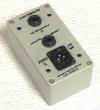
 mounted
in the box
Hammond 1590-TBK

thanks to Lukas Meier
who etched the first
black prototype pcb
old orginal
schematic
new schematic
matching
the pcb-layout
thanks to
Ray Thomson
the first pcb-layout
january 2010 rev.1
layout by
Soeren_DK
and
Luny Tune
no
longer for sale,
only used as
model for
self-etching
projects
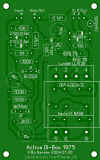
the new pcb
may 2015
rev.2
same as rev.1
except some small
changes in
placement and text
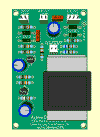
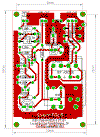 this
new pcb layout
is a collaboration
between my self,
Soeren_dk,
Luny Tune and
Volker Mayer ordering
of PCB
can be done here
Lundahl LL1538 
Haufe ST8456

OEP A262A3E
 |











